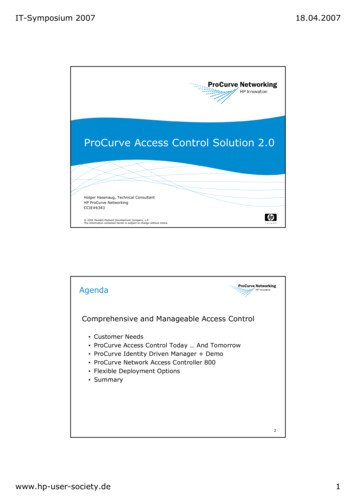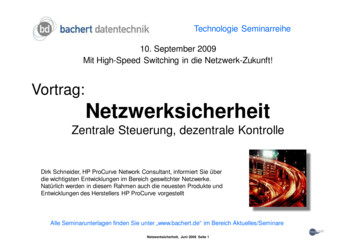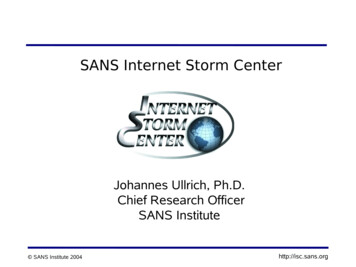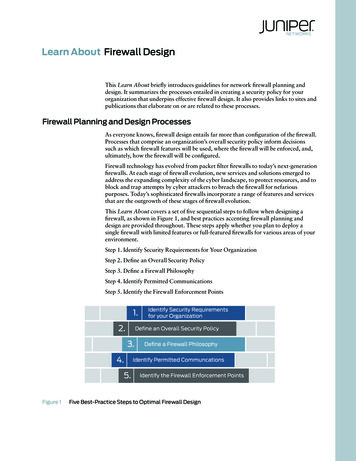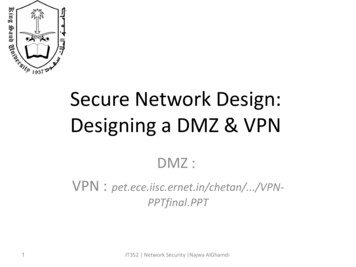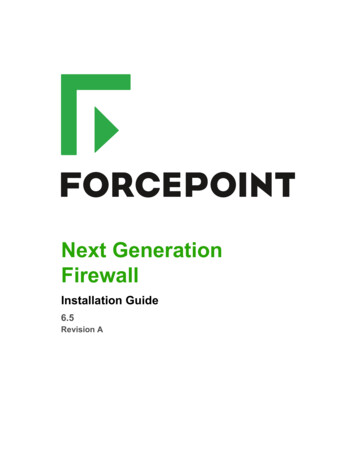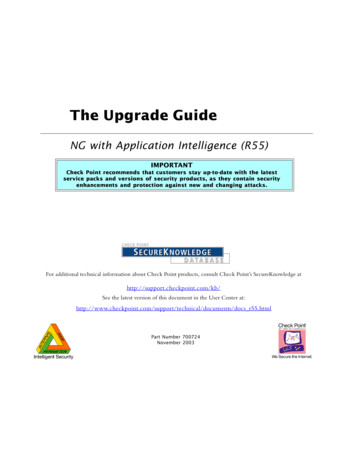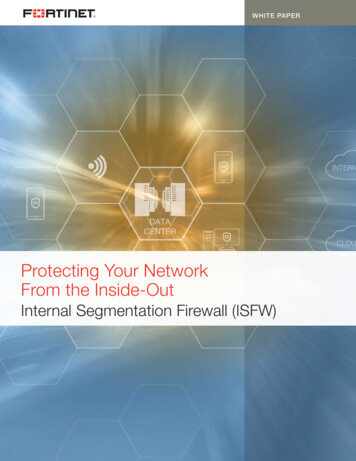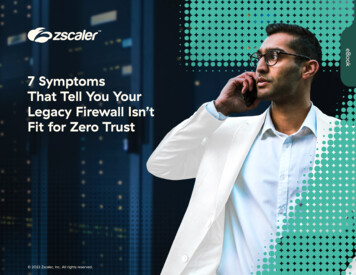
Transcription
eBook7 SymptomsThat Tell You YourLegacy Firewall Isn’tFit for Zero Trust 2022 Zscaler, Inc. All rights reserved.
Zero Trust adoption is on the rise eBookToday’s IT security stakeholders are well aware that zero trust is the rightsecurity model for modern digital businesses. Surveys show that as manyas 78% of enterprise security programs have either adopted zero trust networkaccess or are planning to do so in the future.1 They know that focusing directlyon securing users, data, and applications—instead of the network—is keyto protecting today’s data-driven, remote work-enabled enterprises.Decades ago, when hub-and-spoke network designs were state-of-the-art,firewalls and the networking infrastructures built around them were young,spry, and healthy. They were the right technology choice for that era, servingfaithfully and doing their jobs well. In the modern cloud computing era,however, their presence is a burden, and castle-and-moat architecturedesigns are fundamentally incompatible with the zero trust paradigm.Here’s a diagnostic guide outlining seven symptoms that your firewall is unfitfor today’s zero trust security world. Any one of these seven symptoms is asign that your organization needs a cloud security cure.1. Source: Cybersecurity Insiders, Zero Trust Adoption Report, 2019. 2022 Zscaler, Inc. All rights reserved.2
SYMPTOM #1A lack of visibility when tryingto inspect traffic at scaleRegardless of their form factor, appliance-based firewalls are simply unable to inspectSSL-encrypted sockets layer (SSL) encrypted traffic at scale. This becomes more and moreof a problem as the percentage of global internet traffic that’s SSL-encrypted increases.Attackers know about this increase and are concealing more and more advanced threatswithin encrypted traffic.85%of global internet trafficis encrypted today.2If your firewall suffers from this condition, you’ll notice a performance degradation of50% or more whenever you try to turn on SSL inspection. You’ll have to upgrade to a highercapacity firewall or add more appliances (or virtual firewall instances) just to maintain theperformance that’s acceptable for your users.WHAT’S THE CURE?Move to a cloud-delivered service that can provide cloudnative firewalling capabilities rather than trying to leverageand scale virtual machine (VM) versions of outdatedphysical appliances. Only true cloud services and solutionsare infinitely scalable to meet today’s traffic needs.85%of network administratorsagree that firewall capabilitiesare best deliveredvia the cloud.32. Source: European Union Agency for Cybersecurity, Encrypted Traffic Analysis3. Source: Zscaler, Network Firewall Survey 2022 Zscaler, Inc. All rights reserved.3
SYMPTOM #2Unawareness of lateral movementFirewalls were designed to protect the perimeter of castle-and-moat style networks. Theidea was that once the firewall had made a decision about whether or not to allow its ingress,all traffic within that perimeter could be trusted unconditionally. In such architectures, mostusers were on-site, more infrastructure was on-premises, and most applications lived withinthe data center. None of these things hold true any longer.Today’s reality is that 70% of traffic is internal to the network, meaning that it flows between64%of today’s network administratorsbelieve that firewalls areineffective at stoppinglateral movement.4servers and applications within the enterprise’s private cloud or data center. Perimeter-baseddefenses leave few if any means for inspecting or blocking this traffic, giving attackers freerein once they’ve gotten into the network.Once you’ve gained access to this sort of network, it’s trivial to discover all the assets to whichit’s connected. The user needs nothing more than an open-source scanning tool to find everyIP address within the network. From there, disseminating ransomware—or exfiltrating valuabledata—is a simple matter, and there’s nothing a firewall can do to stop it.WHAT’S THE CURE?Implement zero trust network access that allows connections only afterverifying device and user identities, verifying security status, and enforcingsecurity policies—for every single connection, every time. This makes itpossible to establish direct and secure connections between users andapplications, rather than unprotected connections to a network.57%of IT decision-makers stronglybelieve that firewalls cannotstop ransomware attacks.44. Source: Zscaler, Network Firewall Survey 2022 Zscaler, Inc. All rights reserved.4
SYMPTOM #3Severe policy inflammationSecurity teams are attempting to achieve zero trust within legacy network architectures byconfiguring policies that segment networks into ever-smaller pieces. This is microsegmentationin theory, but the effort and administrative effort required for upkeep quickly becomeunmanageable in practice.To protect today’s applications, businesses must deploy growing numbers of virtual firewallsall over the network. This results in a tsunami of policies that requires endless configurationand reconfiguration to build something resembling zero trust enforcement.Like their physical appliance ancestors, virtual firewalls cannot scale beyond a certain point.Eventually, you’ll need thousands, if not tens of thousands, of policies, which creates amanagement nightmare.WHAT’S THE CURE?The secret is separating networking from application and resource access control. Zerotrust network access makes it possible to grant individual users direct and secure access toapplications, not network segments. This means that users can be connected right to theapplications they need while traffic follows the shortest possible path, and administratorsand security teams no longer need to worry about the underlying plumbing.It can’t be deployed overnight, but its diligent implementation can simplify IT, network,and security management while offering better performance for end users. 2022 Zscaler, Inc. All rights reserved.5
SYMPTOM #4The risk of infection spreadingacross your public cloud assetsPublic cloud providers offer virtual firewalls on their online software marketplaces that aresupposedly certified to meet their customers’ needs. These firewalls are often nothing morethan virtual versions of appliance-based firewalls running as VM instances in the public cloud.Running one of these firewalls in the cloud essentially extends your legacy network architectureoutwards to encompass cloud resources. This gives attackers who can breach your firewallbased defenses the opportunity to move freely within an expanded network and opens accessto your cloud assets to anyone inside your network.Remember,firewalls werenot designedto stop lateralmovement.Additionally, configuring policies to govern traffic between workloads in the public cloud andvirtual private clouds is messy and cumbersome. You’ll need virtual firewall instances on everyegress and ingress point in your cloud architecture. Think for a moment about the cloud’sinherent interconnectivity, and you’ll quickly understand why this design is so unwieldy.Plus, you’ll have to manage a convoluted routing and networking infrastructure just to makethis cloud architecture work with the rest of your legacy network.WHAT’S THE CURE?Invest in a modern platform that acts as an exchange between workloads, no matterwhere they’re located. This both prevents attackers from moving laterally to accessnetwork resources and simplifies management and troubleshooting. Plus, it givesadmins granular, conditional access control that can be revoked if context is changed. 2022 Zscaler, Inc. All rights reserved.6
SYMPTOM #5Permit any-any” addictionspiraling out of controlCloud transformation is changing business on a global scale, and organizations acrossall industries are leveraging the agility and freedom to innovate offered by the cloud.If you’re part of an IT or security team, it’s simply a matter of time until you deal with85%of organizations will haveadopted a cloud-firststrategy by 2025.5a cloud migration project—if you aren’t already doing so.The problem is that it’s taxing and cumbersome to configure legacy firewall-basedarchitectures to secure cloud assets. Policies proliferate, complexities abound, andwhat’s more, users need access to applications to be productive. What can you do?90% of IT and security administrators admit that they have applied highly permissive policies*—at least temporarily—to speed up projects and give users the access that they need.Over time, permissive policies add up and are eventually ignored or forgotten, increasing theorganization’s risk of suffering a breach or falling victim to a devastating ransomware attack. Ofcourse, these practices directly contradict those of a zero trust, least-privileged access approach.WHAT’S THE CURE?95%of new digital workloadstoday are being deployed oncloud native platforms.5Seek out a cloud based zero trust solution that’s simple to implement and operate. Not onlywill a unified zero trust platform with a single management console be easier to configureand manage, but it will offer more robust security than a legacy perimeter firewall.5. Source: Gartner, “Gartner Says Cloud Will Be the Centerpiece of New Digital Experiences” 2022 Zscaler, Inc. All rights reserved.7
SYMPTOM #6Potentially infectious internet exposurePerimeter firewalls were designed to serve as network front ends. They’re internet-exposed assetsby nature, allowing direct access to internal networks and resources if they’re breached. This meansthat using a legacy firewall as a gateway to deploy virtual private network (VPN) services inherentlyputs your network at risk.The severity of these risks is evidenced by a string of recent successful breaches by attackers whoexploited vulnerabilities in legacy VPNs. The Colonial Pipeline ransomware attack, the largest publiclydisclosed cyberattack against critical infrastructure ever to take place within the US, occurred whenattackers “exploited a legacy VPN that shouldn’t have been in use,” according to the company’s CEO.6Firewall based VPNs offer no way to implement granular access controls or restrict which users canFirewall-based VPNsoffer no way toimplement granularaccess controls orrestrict which userscan connect toparticular resources.connect to particular resources. Hence, relying on VPNs is an all-or-nothing approach that extendsyour network’s attack surface from the cloud all the way to individual employees’ home wirelessrouters and networks. And, the further out your network expands, the more damage attackers cando, and the faster they can do it.WHAT’S THE CURE?Look for a VPN alternative that enables secure access to applications by establishing one-to-one connectionsbetween users and applications on a dynamic identity- and context-aware basis. Such solutions use inside-outconnections that make apps invisible to the public internet, delivering better performance than VPNs alongsidedramatic improvements in security.6. Source: “Colonial Pipeline hack explained: Everything you need to know,” TechTarget, April 2022. 2022 Zscaler, Inc. All rights reserved.8
SYMPTOM #7Traffic congestionThe distributed enterprise has entered the mainstream, and most companies are embracinghybrid and remote working models to keep up. But when a large number of users are remoteand you’re still relying on a legacy castle-and-moat network architecture, you’ll need to backhaullarge amounts of traffic back to the corporate data center for an inspection by your firewall.Needless to say, this architecture is illogical and complex. Legacy firewalls and appliance-basedsecurity stacks are time-consuming and cumbersome to manage. If you’re using leased MPLSlines, you’re paying a premium for a complex routing, switching, and traffic segmentationinfrastructure. This is why interest in software-defined wide area networking (SD-WAN) isincreasing—but adding network overlays only serves to increase the complexity and costsassociated with firewall management.Application performance and end user experiences both suffer when you’re backhauling traffic.Not to mention latency, a perennial problem that becomes even more of an issue as organizationsrely more heavily on bandwidth-intensive communications apps like Zoom and Microsoft Teams.WHAT’S THE CURE?A cloud-based zero trust solution places security controls where today’s usersand applications reside—in the cloud. It enforces policy inline and at the edgeso traffic doesn’t need to make any extra hops. And because it operates in thedata path, a zero trust platform can monitor every connection and automaticallypinpoint and remediate performance issues. 2022 Zscaler, Inc. All rights reserved.9
Our approach makes zero trust security accessible and simple forTHE ZERO TRUST CUREHow Zscaler canheal your networkand its architectureour customers. That’s why industry leaders and expert analystsagree that the Zero Trust Exchange is the most mature, easiest-touse zero trust platform.Deploying the Zscaler Zero Trust Exchange is fast and easy, andit offers a comprehensive array of integrated inline security thatsupercharges its leading security service edge (SSE) capabilities.These include:The Zscaler Zero Trust Exchange is a cloud native platform purpose Cloud-gen firewallconnections based on the principle of least-privileged access, and it Advanced cloud sandboxinginspects content deeply and verifies access rights based on identity Secure web gateway (SWG) Data loss prevention (DLP) CASB and morebuilt for zero trust. The Zero Trust Exchange allows direct and secureand context before permitting any connection to be made.Zscaler’s AI/ML-based policy engine, powered by the world’slargest security cloud, understands context based on user, device,and application information and uses this context to make intelligentdecisions about access levels and restrictions to keep users anddata safe. And the Zero Trust Exchange brokers direct one-toone connections between users and applications, ensuring thatapplications are invisible to the internet, eliminating the attack surface.For more information, cessAbout ZscalerZscaler (NASDAQ: ZS) accelerates digital transformation so that customers can be more agile, efficient, resilient, and secure.The Zscaler Zero Trust Exchange protects thousands of customers from cyberattacks and data loss by securely connecting users,devices, and applications in any location. Distributed across more than 150 data centers globally, the SSE-based Zero TrustExchange is the world’s largest inline cloud security platform. Learn more at zscaler.com or follow us on Twitter @zscaler. 1 408.533.0288Zscaler, Inc. (HQ) 120 Holger Way San Jose, CA 95134 2022 Zscaler, Inc. All rights reserved. Zscaler , Zero Trust Exchange , ZscalerInternet Access , ZIA , Zscaler Private Access , ZPA and other trademarks listedat zscaler.com/legal/trademarks are either (i) registered trademarks or service marksor (ii) trademarks or service marks of Zscaler, Inc. in the United States and/or othercountries. Any other trademarks are the properties of their respective owners.zscaler.com
Here's a diagnostic guide outlining seven symptoms that your firewall is unfit for today's zero trust security world. Any one of these seven symptoms is a sign that your organization needs a cloud security cure. Zero Trust adoption is on the rise 1. Source: Cybersecurity Insiders, Zero Trust Adoption Report, 2019.
